
San Jacinto Peak is one of the true crowns of Southern California and is a crowning achievement for any hiker who reaches the summit. San Jacinto Peak is the second highest mountain in Southern California and the pinnacle of the San Jacinto Mountain Range at 10,834 feet above sea level.
Hikers who spar with San Jacinto Peak should be prepared for an all day challenge. The tough routes to the summit include Marion Mountain Trail, which is the shortest tram-free route, presenting a 13.2-mile round trip day hike with 4,500 feet of elevation gain. If you are wondering if the views at the summit are worthy of the effort, the answer is yes. The 360-degree panorama on San Jacinto Peak is practically unbeatable!
The basic directions for this hike are:
- Begin up Marion Mountain Trail from Marion Mountain Campground Road (0 miles)
- Cross a road near Marion Mountain Campground (0.35 miles)
- Stay to the right past a path down to Marion Mountain Campground (0.45 miles)
- Cross a dirt road (0.5 miles)
- Enter San Jacinto State Park Wilderness (1.6 miles)
- Turn right at the top of Marion Mountain Trail, followed by an immediate right up Deer Springs Trail (3 miles)
- Stay to the right past Fuller Ridge Trail (3.55 miles)
- Enter Little Round Valley Trail Camp on Deer Springs Trail (4.8 miles)
- Exit Little Round Valley Trail Camp (5.1 miles)
- Turn left up San Jacinto Peak Trail or stray forward a bit farther on Deer Springs Trail to an nice overlook (6.3 miles)
- Pass San Jacinto Shelter (6.5 miles)
- Reach the summit of San Jacinto Peak (6.6 miles)
- Return by the same route (13.2 miles)
San Jacinto Peak lies within the San Jacinto State Park Wilderness, and you should pick up a wilderness permit before setting out up the trail (details below). Marion Mountain Trail approaches San Jacinto Peak from the west-southwest. A sign at the trailhead falsely the distance to San Jacinto Peak (Mount San Jacinto) as 5 1/4 miles, which unfortunately is an understatement. A second sign states that you are three miles from Santa Rosa and San Jacinto Mountains National Monument.
Begin up the trail near the end of Marion Mountain Campground Road. Immediately past the trailhead, you will pass a shortcut path on the left that cuts out the first switchback on the trail. Since plenty of steepness lies ahead, you may want to stick with the main trail, which angles to the right before swinging back to the left.
Climbing up the mountainside, you will get westward views above the Jeffrey pines toward Indian Mountain, a summit lower down the San Jacinto Mountains, backed by the valley far below the range.
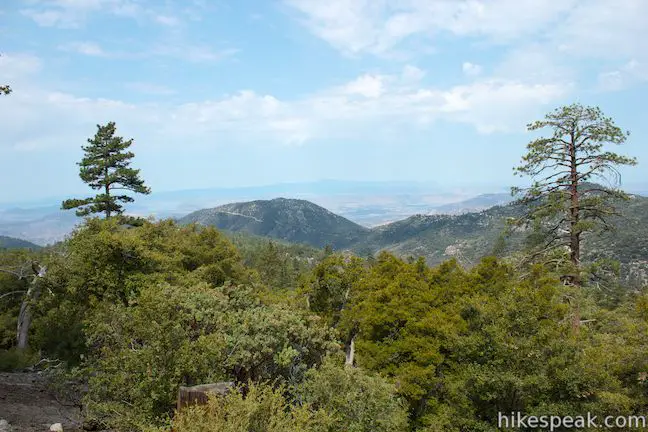
A quarter mile from the start, the trail curves to the right and you will spot Marion Mountain Campground just below the trail. Proceed straight across a dirt road coming up from the campground, 0.35 miles from the start and continue another tenth of a mile to a path heading down to the left past a holding tank above the campground. The campground bathrooms are visible a tenth of a mile below. Since the trailhead does not have bathrooms, you can make a short detour here if need be. Marion Mountain Campground can also be used as a alternate starting point for this hike, trimming the trek to San Jacinto Peak to about 12.5 miles round trip.
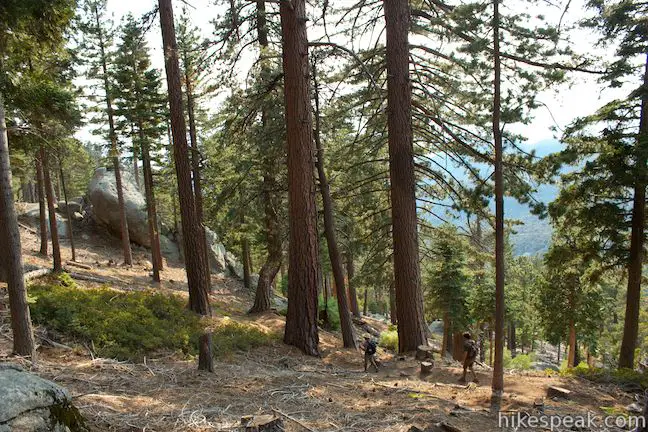
Just past the path down to the campground, and half a mile from the start, cross another dirt road and continue up the rock and dirt single-track trail. Marion Mountain Trail presents a steady climb with lots of steep stretches and just a few tapered breaks. With 4,500 feet of elevation to tackle in 6.6 miles, the hike never relents for long.
Maroin Mountain Trail crosses a sloped forest of pines and boulders. Pass patches of ferns and wildflowers that bloom in the summer like lupines, columbine, shooting star, and Indian paintbrush. You can watch butterflies dance between the flowers, but if you stop too long, mosquitos will start to buzz you off.
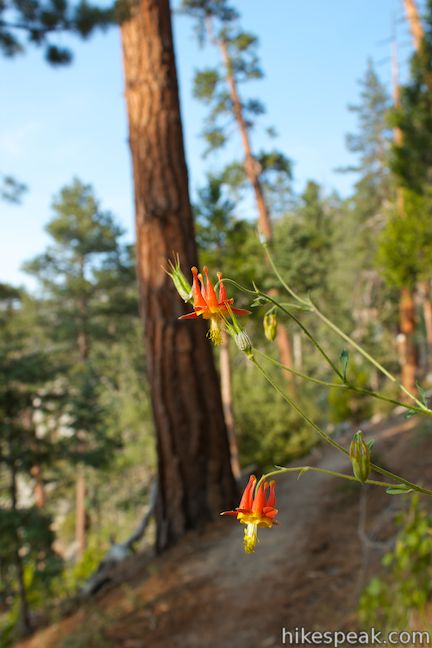
Several switchbacks and one stone staircase lead farther up the mountainside. Looking through the sugar pines to the left, enjoy intermittent views of Fuller Ridge, a dominating ridgeline on the north side of San Jacinto Peak.
At 1.6 miles from the start, pass a sign marking the boundary of San Jacinto State Park Wilderness. Just ahead, 1.75 miles from the start, a perch of exposed granite on the left side of the trail will lure you briefly off trail. Step out on the rocks for clear views across the pine-covered canyon toward Fuller Ridge. While the trail to the summit is steep, several nice places like this allow you to stop to take a break, catch your breath, and catch some great views.
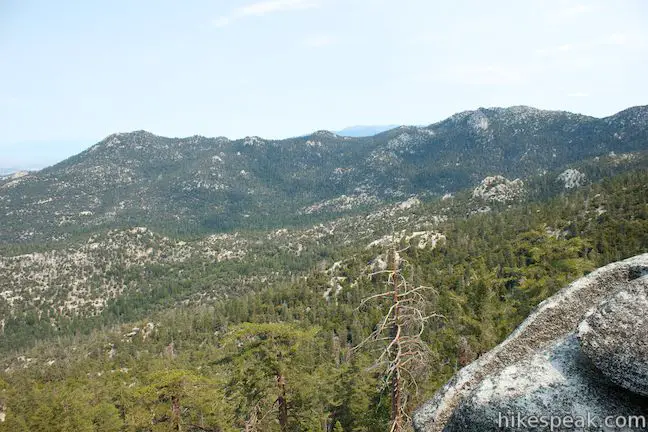
When you are ready to go again, continue up the trail, climbing the pine and boulder-covered mountainside. Finally, around 2.9 miles from the start, Marion Mountain Trail tapers out for a stretch, passing a lovely meadow on the right.
Marion Mountain Trail comes to an end at a T-junction with the Pacific Crest Trail, three miles and 2,350 feet above the trailhead. Turn left, walk a hundred feet to a junction with Seven Pines Trail, and turn right up Deer Springs Trail (which is also the Pacific Crest Trail up until the next junction).
Things stay relatively gradual for the next 0.55 miles as you cross through a lush forest past a trickling stream to a junction with Fuller Ridge Trail. Stay to the right to proceed toward the summit of San Jacinto Peak.
A few hundred feet past the Fuller Ridge Trail Junction, Deer Springs Trail leaves the pines (temporarily) and starts up a string of switchbacks on a slope covered in thorny brush. The low brush opens things up for views above the forest toward Fuller Ridge and the mountains and canyon below.
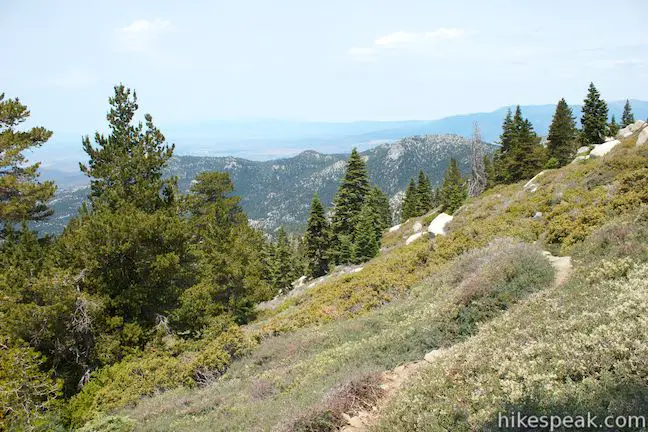
Returning to the pines, Deer Springs Trail climbs through boulders to a saddle, 4.1 miles from the start and 0.55 miles from the Fuller Ridge Trail Junction. The trail tapers for a stretch and passes a triplet of creeks. If you are planning to filter drinking water along the trail, the first creek, 4.4 miles from the start, has the strongest summer flow. The third little stream, 4.55 miles from the start, is lined with shooting star wildflowers and is also quite lovely. These seasonal streams swell from snow runoff in the spring but slow to a trickle by late summer.
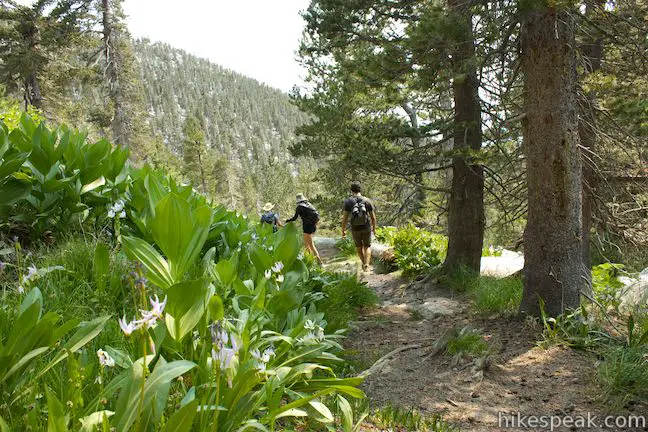
Come to a trail marker at the bottom of Little Round Valley Trail Camp, 4.8 miles from the start. Deer Springs Trail continues through the campground, which has a few numbered campsites with fun names like Nutcracker Perch, Owl’s Hootch, and Thunder View. A port-o-potty for the campground can be found just past a meadow covered with corn lilies.
Exit Little Round Valley, 5.1 miles from the start and begin the final climb on Deer Springs Trail. The gnarled pines become more scarce and the boulders grow larger as you switch up the mountainside. Surprisingly, you won’t get a clear view of San Jacinto Peak until you are right at the summit, but you will have nice views down the mountainside to the west.
Once you’ve hiked 1.2 miles above Little Round Valley, you will come to the final trail junction in a saddle on the south side of San Jacinto Peak. (As a bonus, if you walk straight a few hundred feet past the junction, you will reach a rocky perch with views east over Palm Springs). From the three-way junction at the top of Deer Springs Trail, turn left up San Jacinto Peak Trail and hike the final 0.3 miles to the summit.
Pass a stone cabin about a tenth of a mile below the summit. A sign on the door notes that “Mount San Jacinto’s Peak Shelter is an historic structure, having been built around 1933 by the Civilian Conservation Corps.” The one-room shelter is open to the public and maintained by its visitors.
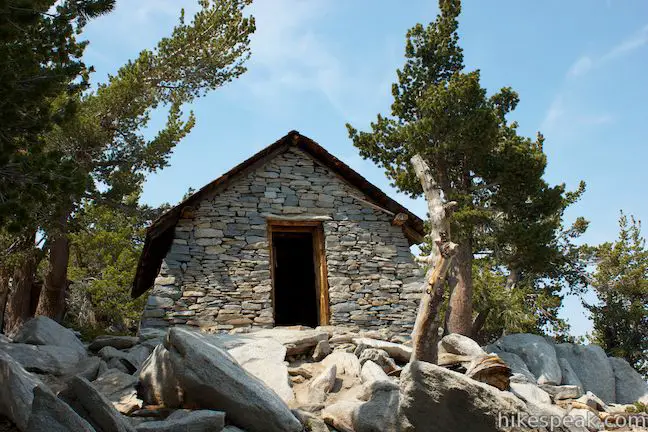
Above the cabin, the trail disappears in a mess of boulders and you are left to find your own route to the top of San Jacinto Peak. A wooden sign marks the distinct summit, which is surrounded by epic vistas. How great is the view from San Jacinto Peak? After visiting the summit, John Muir wrote that the view was:
The most sublime spectacle to be found anywhere on this earth.
While urban sprawl and worsening air quality have diminished the view that so impressed John Muir, the summit 360 is still one of Southern California’s best. To the east, you can look down the mountainside toward the desert surround Palm Springs. If you look closely at the rocky ridge above the city, you will spot the top of the Palm Springs Aerial Tramway.
To the northeast, the Little San Bernardino Mountains are visible crossing Joshua Tree National Park. North of San Jacinto Peak, the mountains drop over 9,000 feet in five miles to the valley floor (crossed by the 10 Freeway). On the other side, the San Bernardino Mountains rise even higher, topping out with San Gorgonio Mountain, the highest point in Southern California, which lines up to the north-northwest of San Jacinto Peak.
The sweeping views continue to the west where the mountains taper to the valley floor filled by Riverside and Helmet. The blue water of Diamond Valley Lake stands out from the surroundings. To the south are views across Tahquitz Peak in the San Jacinto Mountains toward the Palomar Mountains on the north side of San Diego County. Indeed it seems like the better part of Southern California is visible from San Jacinto Peak.
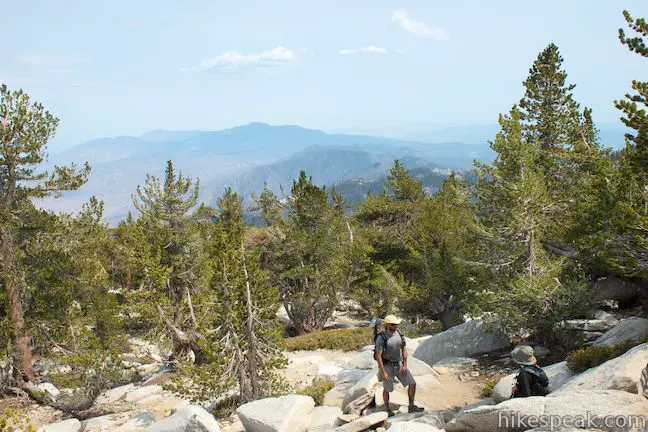
While you probably won’t pass many hikers on the way up to San Jacinto Peak, the summit can actually get crowded on weekends. Walk out along the rocky ridge to the north to find a place all to yourself to enjoy the views north toward San Gorgonio Mountain and east over Coachella Valley.
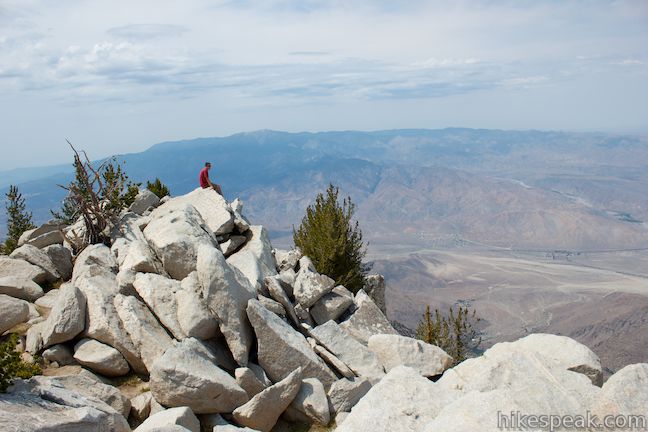
When you are ready to return, hike back the way you came. The hike down is steep too, and while the scenery along the way is always beautiful, that beauty could start to feel monotonous on the long hike down when your legs are screaming for the hike to be over. Try not to rush down the trail and put extra pressure on your knees and ankles. The ever-present birdsong along the trail should help to keep you at a pleasant pace. You’re legs are bound to be tired when you finish the hike, but the rest of you should be quite pleased with the accomplishment.
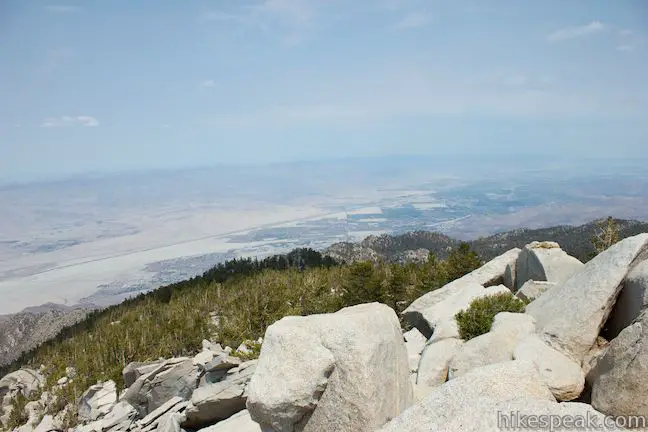
Get a permit! A wilderness permit is needed to hike Marion Mountain Trail, but no fee is required to park at the trailhead (a National Forest Adventure Pass is no longer required). Dogs and mountain bikes are not permitted on the hike to San Jacinto Peak. You may apply for a wilderness permit online or pick one up at the self-issue station at the nearby Mount San Jacinto State Park Headquarters located at 25905 Highway 243 in Idyllwild. Call 951-659-2607 for more information about wilderness permits. Marion Mountain Trail does not have a quota limiting the number of hikers, so picking up a permit is quite easy. An additional permit is required to camp and Little Round Valley Trail Camp.
To get to the trailhead: From Banning, which is 80 miles east of Los Angeles on the 10 Freeway, drive south on Route 243 up into the mountains for 19 miles to Azalea Trails Road (Forest Route 4S02), which will be on the left (east) side of the road. (Coming from the other direction, Azalea Trails Road is 5.5 miles north of Idyllwild on Route 243.)
Turn up Azalea Trails Road, following signs for Marion Mountain. It is 1.5 miles from Route 243 to the Marion Mountain Trailhead. Make an immediate left at the first intersection followed by a pair of right turns. From the last turn onto Marion Mountain Campground Road, it is 0.7 miles to the Marion Mountain Trailhead, which will be on the right across from a dirt parking lot. Park here. The road ends in another quarter mile at Marion Mountain Campground.
Trailhead address: Marion Mountain Campground Road, San Bernardino National Forest, Idyllwild, CA 92549
Trailhead coordinates: 33.79117, -116.735386 (33° 47′ 28.21″N 116° 44′ 07.38″W)
View San Jacinto Mountains in a larger map
Or view a regional map of surrounding Southern California trails and campgrounds.
 | Indian Mountain This 6-mile round trip hike crosses a saddle to a 5,790-foot summit with views of the mountains around San Jacinto Peak near Idyllwild. |
 | Ernie Maxwell Scenic Trail This gradual 5.2-mile round trip hike near Idyllwild crosses quiet forests with rugged mountain views. |
 | Canyon View Loop Trail This 3.75-mile loop in Whitewater Preserve crosses Whitewater River and incorporates a section of the Pacific Crest Trail to deliver big views up and down Whitewater Canyon on the east end of the San Bernardino Mountain. |
 | More hikes in Southern California Explore more trails in Orange, Riverside, San Bernardino, and San Diego counties. |
San Jacinto Peak via Marion Mountain Trail on socalhiker.net
San Jacinto Peak via Marion Mountain Trail on myown100hikes.blogspot.com
San Jacinto Peak via Marion Mountain Trail on thelatebloomerhiker.com
San Jacinto Peak on wikipedia.org
San Jacinto Peak on summitpost.org
The national forest webpage for Marion Mountain Campground
The San Jacinto State Wilderness Permit Application
The San Bernardino National Forest Wilderness Permit Application (also valid)
The national forest webpage for Marion Mountain Trail
The official webpage for San Bernardino National Forest
The official website for Santa Rosa and San Jacinto Mountains National Monument


























































































we are planning to hike this trail this weekend. what is the air quality after the fire?
@dawn, how was the hike? We’re looking to hike it this weekend.
Me and a buddy hike mt san jacinto on 6/10/14 it was a strenuous hike and even more so climbing back down, it was grueling decent, knees was screaming uncle lol, but the view at the summit was outstanding and breathtaking, it was windy and clear view of the surrounding area, definitely recommended, next one mt san gorgonio….
Are dogs permitted?
No dogs for this hike, but you can try nearby Ernie Maxwell Scenic Trail and Indian Mountain Trail.
[…] Another great post about going up the Marion Mountain Trail […]
[…] Source: San Jacinto Peak via Marion Mountain Trail on Hikespeak.com […]
I want to start my hike from the tram please send me information from that point distance/length and how long would it take and from there do you need extra water what is the best time to start and end so I can ride tram back down to my vehicle. Thanks for your help.
The link for the permit takes you to the state park application. Just spoke to someone and I was told for this hike you need the federal park permit which is here.
http://www.fsva.org/pdf/Wilderness%20Permit%20App%20MSJW.pdf
Hi Debbie,
Thanks for the information. I was told in 2013 that either permit was valid. However, on the national forest wilderness permit it says “Use this form if you plan to camp in USFS managed wilderness. This form is not valid for CA state wilderness permit.” This makes me question whether the national forest wilderness permit covers hikers on Marion Mountain Trail, which goes into the state wilderness.
Has anyone hiked this trail recently? What permit did you use?
Either day use permit is accepted to hike the mountain because the trails cross over between USFS and State Park lands. The specific agency permit is required when overnight camping. You have to get a camping permit from the agency in whose land you are camping in.
Seems so refreshing! the view is wonderful…If one has never appreciated nature before, this will make you.
My friends and i want to go hiking to this trail but i was reading this article and it says that i need a permit. When i click on the link it opens up the form, do i fill that form even tough i don’t want to stay overnight?
Yes, you will need to fill out and mail in that form even if you are not staying overnight. You can also get a permit from the State Park Headquarters in Idyllwild or at the Long Valley Ranger Station.
I hiked this back in 97. Drove up from San Diego (I was in the Navy)and back the same day. Wasn’t specifically looking to hike to the peak; I was just interested in taking the tram ride (using the “old style” tram cars). Anyway, had my pack (I take my pack just about everywhere I go)and plenty of water so I decided to go up. Great hike. I highly recommend it. The views down to the desert were fantastic. Bring water or some way to purify. I went up in August; warm at elevation but didn’t seem too hot. Low humidity so you’ll drink more than you might think. At the time the trail passes were in a mailbox like thing at the trail head. Bugs, specifically mosquitoes, didn’t seem bad but I am from MN. You won’t regret doing this.
I don’t see a lot of comments about water on this trail. We did this hike overnight in 8/9-10/2020 and we crossed 6 streams on the way up from the trailhead to Little Round Valley. 5 of the 6 are useable to collect water if you have a filter pump. Gorgeous views, highly recommend, but defy strenuous.
Thank you Eric!!! This is just the info we were looking for.